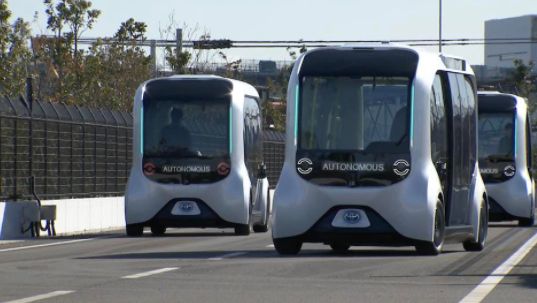With under one month to go until the Tokyo Olympics and Paralympics begin, main sponsor Toyota has intensified the final practice runs of its e-Palette electric autonomous vehicles that will ferry athletes and staff from the Olympic Village to venues and back. And so far, everything is running smooth and driverless.
The e-Palette first debuted at the Consumer Electronics Show in January 2018 when Toyota president Akio Toyoda announced his firm’s bold goal to transition to a mobility company. According to Toyoda, the driverless e-Palette is geared towards enhancing practical MaaS (mobility as a service) applications in the near future, and in one of its first trials in the real world, will form the bulk of Toyota’s electrified vehicle Olympic fleet.
Speaking of the Games, it should be stressed that Covid infection rates in the greater Tokyo area are hovering over 400 per day, and 6-day quarantine protocols are now being imposed on delta variant infected athletes and staff arriving from Uganda, Indonesia and several other countries as the new stronger variant spreads in Japan. Even in the face of another potential state of emergency, should infection rates rise rapidly, the Japanese government and the International Olympic Committee have decided that the Games will go ahead no matter what.
And it’s up to Toyota to supply the lion’s share of athlete transportation which totals around 3,700 mobility products and vehicles, 90% of which will be electrified. Among this sizable fleet, Toyota will provide approximately 500 FCEVs including the hydrogen-powered Mirai sedan, and around 850 EVs including approximately 20 e-Palette vehicles. In addition, 200 Accessible People Movers (APM), which are sized and shaped similarly to the e-Palette but have open sides, will operate within the so-called ‘last one-mile’ of the Olympic stadium to ensure athletes and staff get to their events.
The company says that each e-Palette to go into service during the Olympics and Paralympics, can ferry up to 20 people or 4 wheelchairs, although social distancing requirements will most probably require that number to be halved. Powered by rechargeable lithium-ion battery packs, each vehicle has a cruising distance of around 90 miles, and a cruising speed of up to 20 mph.
But probably most significantly, the e-Palette will employ Level 4 autonomous driving capability, although for safety reasons, each vehicle will have an operator onboard to ‘monitor’ the automated driving and cater to passenger needs. As you might expect, these vehicles are also fitted with the latest version of Toyota’s Safety Sense technologies.
Also destined for Toyota’s ambitious carbon-neutral, hydrogen-powered ‘Woven City’ project taking shape at the base of Mt Fuji, the e-Palette is an integral part of that Olympic Village transport framework and may be defined as ‘Autono-MaaS’ which refers to just-in-time mobility services that “go to where it is needed, when it is needed, and on time.” Let’s hope that Toyota’s ‘on time’ policy is flexible enough to react to any unforeseen Covid complications, should they arise.

